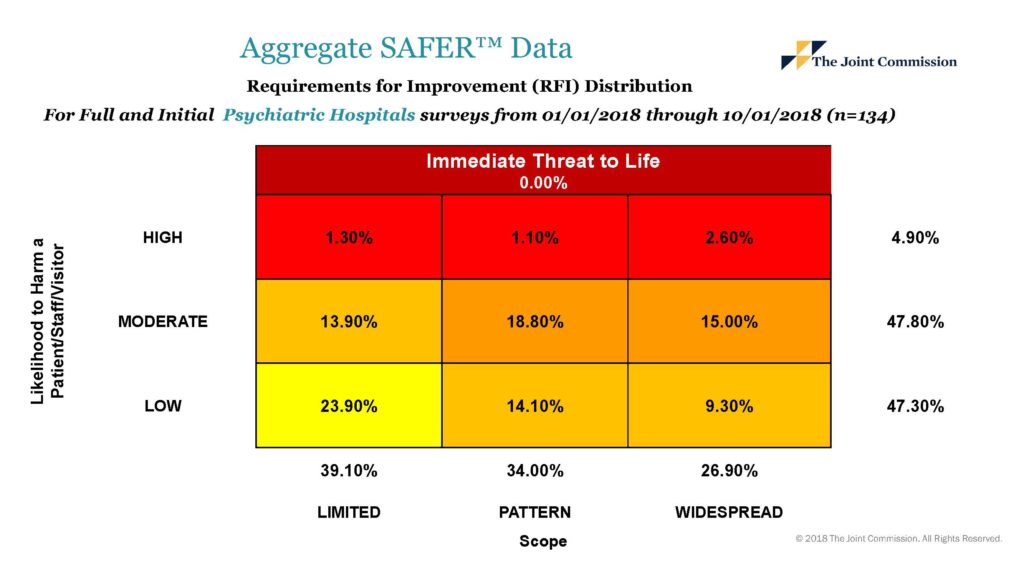So, you survived your latest TJC survey! You’ll tackle your deficiencies and maybe prepare for a follow-up survey. But you’re curious how your results compare to other organizations. TJC recently shared updated aggregate data with members of the Consultants Forum. It’s pretty informative. So, we’ll summarize the data and cut to the key takeaway points.
TJC Surveys: 2018 Psychiatric Hospital Data
From January through September 2018, TJC conducted 134 initial and triennial surveys of psychiatric hospitals. The chart below shows the distribution of Requirements for Improvement across the SAFER matrix.
Some key points: None of these hospitals received an Immediate Threat to Life finding. The majority of TJC survey findings were in the Low and Moderate Risk categories. Only 2.6% were in the High Risk/Widespread category. However, keep in mind that it’s not only findings in the High Risk/Widespread box that can create a Condition Level Deficiency (CLD.) A pattern of findings in the lower risk categories can also cause a CLD. (See our recent post Joint Commission Surveys: High Risk Areas.)

Most Frequently Cited Clinical Elements of Performance (EPs)
Let’s exclude Environment of Care and Life Safety findings for now and focus on the clinical EPs. Here’s the Top Ten list:
- Mental status exams PC.01.02.13 EP 2
- Treatment plans PC.01.03.01 EP 6
- Discharge summaries RC.02.04.01 EP 3
- Treatment plans PC.01.03.01 EP 5
- Treatment plans PC.01.03.01 EP 1
- Suicide risk assessment NPSG.15.01.01 EP 1
- Treatment plans PC.01.03.01 EP 43
- Neurological exams PC.01.02.13 EP 6
- Medical record documentation RC.02.01.01 EP 2
- Treatment plans PC.01.03.01 EP 23
The most frequently cited clinical EP was for mental status exams. Typical issue is not documenting how insight, judgement, memory, and intellect were assessed. (See our post Tips for Documenting the Mental Status Exam.)
Five of the top ten clinical findings were for treatment planning. No surprise there! The issues are familiar. Treatment plans are not measurable, not individualized, not revised, not related to assessments, etc. (See our recent post Treatment Planning in Behavioral Healthcare: Survey Challenges.)
Discharge summaries ranked # 3. Most common problem is not including all three elements required by CMS for the patient’s condition at discharge. These are psychiatric condition, physical condition, and functional condition.
Suicide risk assessment is the sixth most frequently cited clinical EP. (See the next section on Top Ten High Risk EPs for more info on this one.)
Neurological exams was # 8. Typical issue is not including all the cranial nerves. Findings related to the Record of Care round out the list. This is a catch-all standard for any type of clinical documentation finding.
The key takeaway from this data is that a cluster of findings for treatment plans, mental status exams, discharge summaries, and neurological exams can cause a CLD for the CMS B Tags (Special Medical Record Requirements for Psychiatric Hospitals.) This means a 45 day follow-up Medicare Deficiency Survey by TJC.
Most Frequently Cited High Risk Clinical Elements of Performance
- Suicide risk assessment NPSG.15.01.01 EP 1
- Suicide risk assessment NPSG.15.01.01 EP 2
- Governing body oversight LD.01.03.01 EP 12
- Medical record documentation RC.01.01.01 EP 5
- Staffing LD.03.06.01 EP 3
- Holding staff accountable LD.04.01.05 EP 4
- Providing care based on orders PC.02.01.03 EP 7
- Treatment plans PC.01.03.01 EP 1
- Treatment plans PC.01.03.01 EP 23
- Resuscitation services PC.02.01.11 EP 2
Here, the picture shifts significantly. Although suicide risk assessment (NPSG.15.01.01) ranked # 6 as the most frequently cited clinical EP, it ranked # 1 as the most frequently cited High Risk clinical EP. If it’s scored as High Risk and Widespread, it’s likely to cause a CLD and a follow-up survey. No doubt the focus on this area will continue with the new requirements effective July 1, 2019. (See our recent post National Patient Safety Goal NPSG 15.01.01: Q&A on New Requirements.)
Some other takeaways in this High Risk category: Surveyors cited leadership for insufficient staffing. This usually relates to nursing staffing. They also cited leadership for not holding staff accountable for their responsibilities. Checking our database, this appears to be a catch-all standard (LD.04.01.05 EP 4.) Issues have included poor documentation, lack of training, unlabeled urine specimens, lack of photos in medical records, and a host of other items.
Treatment planning was # 8 and 9 on this High Risk list. A few psych hospitals received a finding for resuscitation services. On our mock surveys, the issue we often find is that nursing staff are not adept at using the resuscitation equipment.
Most Frequently Cited Environment of Care and Life Safety Elements of Performance
No surprises here. Ligature risk issues were the most frequently cited EP and the most frequently cited High Risk EP. This can cause a CLD and a follow-up survey. However, be aware that there is an extension request process for long term ligature risk solutions. (See our post Update on Surveying of Ligature Risks.) Learn more about how our Life Safety reivews can help you.
Average Number of Requirements for Improvement
The average number of RFIs for psychiatric hospitals from January to September 2018 was 30.8. The average number of RFIs for all hospitals (including both acute care and psychiatric hospitals) was 32. (Surprisingly close given that most psychiatric hospital have far fewer beds than acute care hospitals.)
Ongoing TJC Survey Readiness
So, how does this data this relate to readiness for your next TJC Survey? As the saying goes, “Forewarned is forearmed.” When preparing for your next TJC survey, focus your efforts on these high risk trends. You’ll avoid the predictable findings, the lengthy plans of correction, and the dreaded follow-up surveys. What a welcome outcome! Also, be sure to stay tuned to TJC news alerts such as the new “411 on Survey Enhancements”.
Stay tuned to our TJC and CMS News Blog!
Our Update on 2018 Survey Outcomes will continue in our next post. We’ll provide similar data on the 2018 TJC survey outcomes for freestanding Behavioral Healthcare Organizations surveyed under the Behavioral Healthcare standards.


